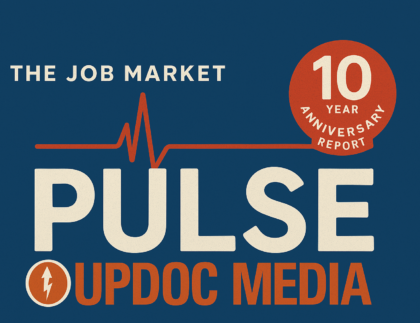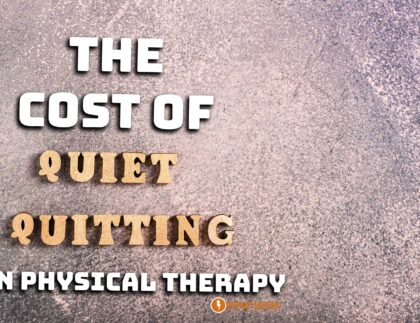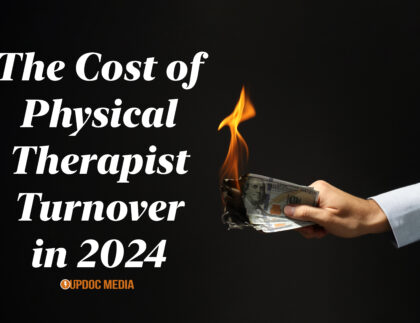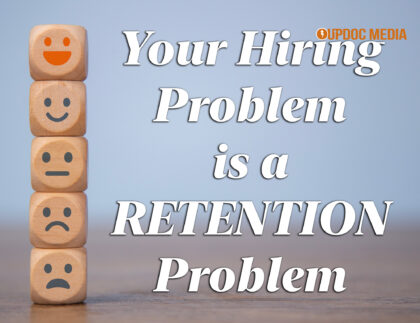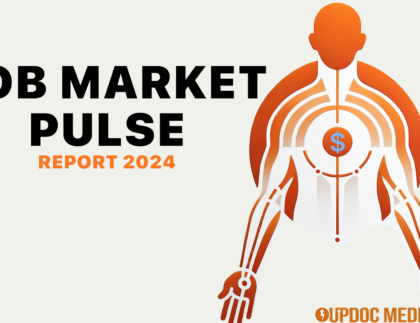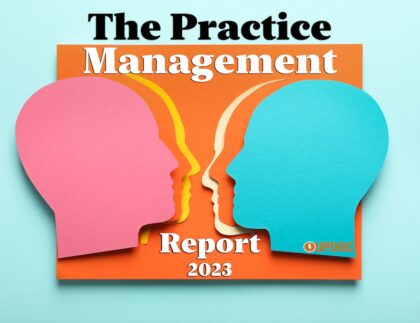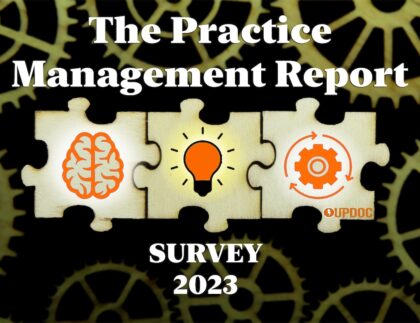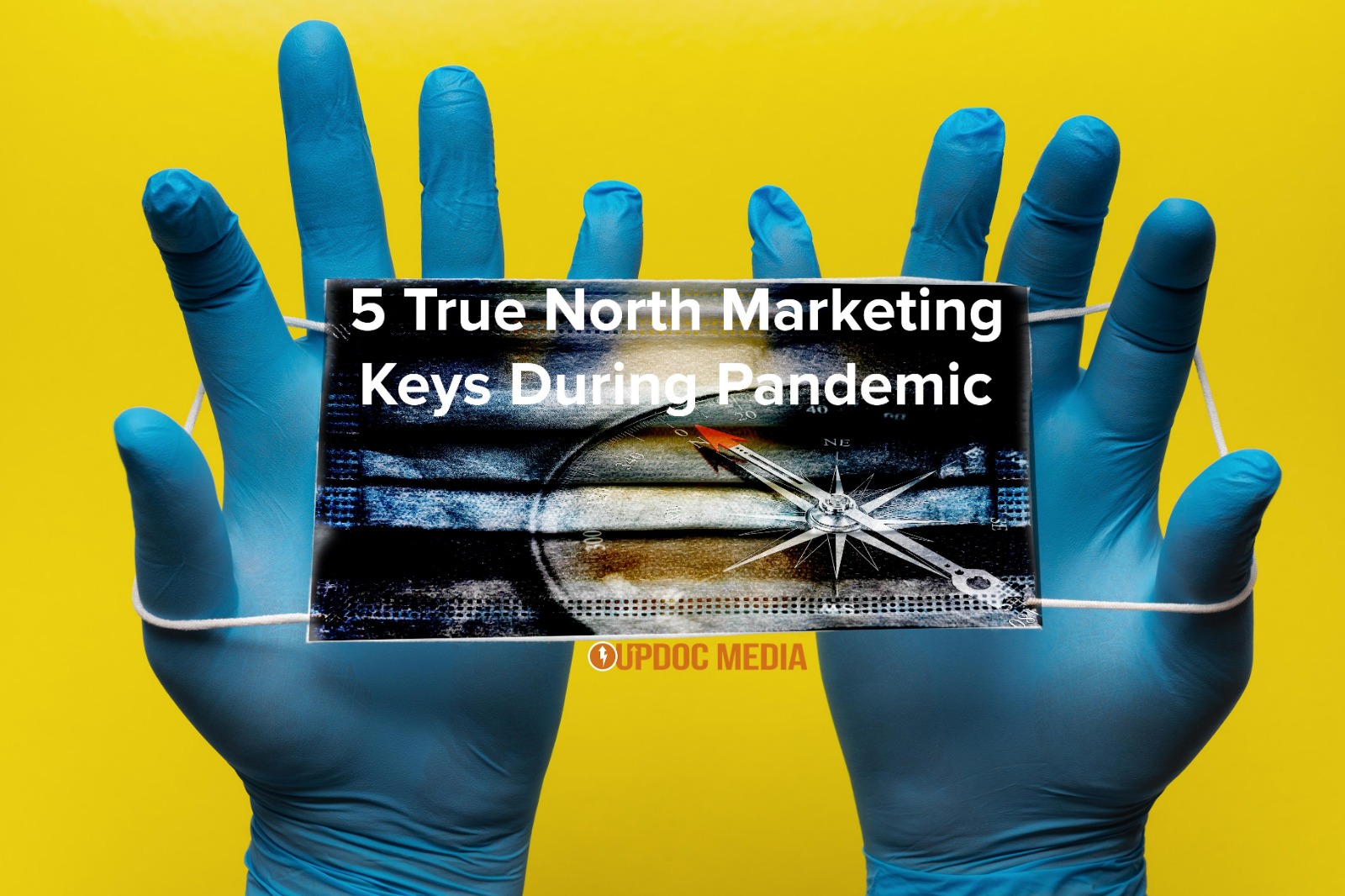
There’s no doubt that COVID-19 has disrupted life as we know it. We’ve released a podcast Hot Take mini-series on the matter — and, in fact, you can listen to all of our Therapy Insider podcasts now on Spotify. But, I digress…! The fact of the matter is, everyone is in a scramble. We’ve addressed this mindset and the dangers thereof in our Digital Healthcare White Paper. Today’s post will centralize on the same theme… respecting the customer, betting on the long game.
Here are…!
5 True North Marketing Keys During Pandemic
1. Less is more.
Now more than ever before, we’re dealing with content clutter — see “Standing Above The Social Media Content Clutter” for more on this topic. The problem is that more isn’t better — better is better. And right now… better is defined by quality, NOT quantity. You don’t want to cause click regret with your audience. #NoClickRegret
While it’s perfectly welcome to post daily or even multiple times a day on your given channel SO LONG AS YOU HAVE WORTHY CONTENT to be consumed… it’s very likely that most brands that have a basis in healthcare or education (and possibly technology) to consider going with the “less is more” maxim. You don’t need to post all the time to get attention. Besides, the attention garnered from that type of over-posting-activity usually isn’t worthwhile to begin with.
People are shopping carefully. They are doing the research. They have the time. They’ve been burnt before and don’t want to be burnt again. Therefore, trust is more important than every before.
While the idea that “this is the first time in human history” perspective on consumer behaviors can get quickly old, what gets old even faster is a breach of trust. Therefore, don’t post just to post; don’t share just to share; don’t send e-mail newsletters just because it’s time to do so. There need to be a reason; purposeful, intentional, highly connective content — THAT is and should be the only reason you hit that publishing button.
For most brand, less will be more… besides, there’s a gamification in this strategy in that most platforms will send an independent ping to mobile devices if your user handle hasn’t shared in a while. Example:

As such… if all your “competitors” have been posting with wild frequency, day in and day out; and, you were to do super high quality content only once a week — your company will have a notification sent out on its behalf to mobile devices for those that follow you saying, “Hey! It’s been a long time since they’ve shared anything. Want to check out what they just posted?” These type of unique notification sets have much higher click through rates than the mass push notifications that “yeah… 89 people have shared something since you last checked the screen.” #LessIsMore
2. Focus on the long game.
It’s easy for highly disruptive environments to foster a focus on short term gains. This is attractive, some may even make a healthy profit off of such activities… most will barely break even, or even lose out significantly. Don’t sacrifice the long term for the short term. Yes, yes…. if we don’t make it through “now,” there will be no “later.” True, very true.
However, I’d submit that if such is the case and you focus on the rather hopeful promises of short term tactics… you’re ensuring two things: (1) That you will not be pointed in the right direction for the long term as the new normalcy settles in, and, (2) that you will not have the momentum required to swing around towards the right direction as a result of all the immediate investment in short term solutions.
While it’d be easy to call out examples of short term traps, it’s of more value to point out their common traits…. such as:
- A foolish amount of cash investment up front with a prospective hope of returns down the line.
- Solution sets being supported primarily by emotional valences rather than data driven objectives.
- Fear based decisions that are made in a short window of time; aka “this opportunity expires in tomorrow… today… here’s a last chance… I know you were interested, I’m making an exception for you!”
- A sudden pivot to niche areas that your organization is neither equipped nor prepared to serve.
- Directions that are based on a desire “not to lose” rather than the aim of “winning.”
Ultimately, the key descriptor of a short term trap is the emotional essence of “escape.” If what you’re exploring seems to be helping you escape for dire or desperately unwanted losses… be wary! Keep your eyes focused on the long game, compass pointed towards true north.
3. Keep watch for fool’s gold.
This caution to short term traps leads us to another key aspect in this critical discussion on marketing keys: watching out for fool’s gold. Unlike short term traps, fool’s gold projects promise long term, sustainable results — some are even backed up seemingly reliable data!
So with that said, what are some important attributes to consider when trying to sift through fool’s gold vs. essential keys for growth?
- Fool’s gold tends to be more attractive for its possession, than for its performance; almost like having a “gold coin” in hand — that “having it” is more important than it actually doing anything productive for you.
- A true north key is dispassionate, objective, and measurable — the results speak for themselves.
- Fool’s gold often appears as a savior in the midst of despair — there’s a predatory psychology that goes with a sudden fulfillment of dreams that is commonly in play here.
- A true north key is commonly steady, and while it has evolved over time — shows consistency with the changing times, rather than something of a transient buzzword.
- Fool’s gold is usually presented as the missing piece of the puzzle; the one thing, that if you would just purchase it or participate in it… would make the world of difference.
- Unlike fool’s gold, a true north key doesn’t promise to save you from anything. Rather, it offers it’s own set of roles and responsibilities as a part of the whole of your company’s marketing strategy and various initiatives.
What are we trying to say here? Ecosystem. Ecosystem. ECOSYSTEM. Whatever it is… it can’t stand alone. It won’t. It will not pass.

Just as a consummate clinician wouldn’t only use a singular interventional technique or approach for any given patient, neither is a comprehensive marketing strategy comprised of a singular golden egg. It’s ALWAYS the system that wins.
PS. What’s a system? Here’s one definition I’ve come to draw upon: “A standardized, self sustaining, self replicating process that exists as a standard operating procedure for your company.”
Moment of caution: I’m not saying do what has always worked. Such an idea flies very much in the face of the forward thinking and innovation focused drives we have here at UpDoc. RATHER, I’m suggesting that your marketing initiatives during this time of pandemic should be redoubled in consumer driven, data supported, measurable and trackable means — all as multiple parts to the ecosystem whole that is your company’s marketing strategy.
Just like the movies: If it doesn’t have a purpose as a valuable addition to the story arc — then it’s a distraction and shouldn’t be utilized. Hmm… kinda sounds like “Less is more?” Boom. There you go.

As is true to the opposite of the short term trap, fool’s gold is ultimately characterized by the emotional essence of “snatching victory from the jaws of defeat.” If what you’re entertaining seemingly offers sudden victory amidst a struggling time of loss or projected losses… you’re probably panning into fool’s gold!
4. Responsibility matters.
Corporate social responsibility (CSR) is an interesting strategic framework and has its ups as well as downs in terms of the business literature out there. Please consider reading these two articles as primer to CSR in the age of COVID-19 as well as 2020 CSR trends. Despite these two articles being rather topically focused within social the scope of CSR, responsibility in and of itself can be far simpler than that as a marketing true north key.
Again, the focus is not social justice. We’re talking about solid business ethics and being a morally responsible community member, regardless of if your organization exists as a solo proprietor, small business, mid-sized company, or operates at true enterprise level scales. Responsibility matters as consumers have and will hold companies accountable with their dollars (not to mention their digital voices) by how they perceive an organization’s dealing… particularly during tough times.
CSR was actually one of my favorite courses when pursuing my MBA, and the evidence laid was rather striking. Ultimately, the theme became this: Responsibility matters because Integrity Matters; and, that’s really what responsibility is — the physical expression of integrity.
Another business icon said it this way — There is…
“No price on integrity.” —Bob Iger
What does integrity look like in the field of marketing?
- Price transparency; before, during, and after transactions.
- A keen focus on delivering value to the customer as a focus of marketing strategy vs. exclusively participating in activities to drive sales.
- Running advertising content that accurately portrays helpful solutions in a non-predatory way.
- Giving where you can, what you can; this is a great way to build trust and goodwill.
- Operating with an open PR policy, not just one that makes the company look good. This will be particularly examined in in the way your organization treats customers; AND… you will also be under the microscope for how you treat your employees.
5. Consumers are smarter than ever. Respect that.
This section is going to start with a rant? Ready? SET. RANT!
Rant #1: Stop calling it “a funnel.“
Just stop. I strongly dislike the imagery behind the word, “funnel.” Consumers are not fish in a barrel to be shoved down some never-ending-automated-funnel to be spammed into submission until they purchase something. It’s such a disrespectful notion; and sadly, many marketing sub-cultures believe in this idea.
For me, I’m old school trained. We always knew “it” as a customer conversion journey — a pathway that consumers take to trusting you, buying from you, and most importantly… buying again. Buying once isn’t hard. Getting someone to buy again requires trust and proof of value.
Besides, we can even look to digital marketing software leaders like Hubspot and how they proudly claim they killed their own funnel model — replaced by a self labeled Flywheel… which PS. is several years old now… because the customer life cycle a la retro business content has been around FOREVER. /EndRant1 #NoMoreFunnel!
If you’re interested in learning about our approach, consider reading about the “Customer Narrative Pathway.”
Respect the shopping intelligence of your consumers and you will have made the first step to establishing a relationship with them as loyal customers.
Rant #2: Value user input, especially online reviews.
We’ve highlighted the incredible importance of online reviews in the past. We will continue to do so because reviews are one of the most reliable ways consumers can pre-shop a service or a product. Of course, there have been concerns regarding the reliability of reviews due to solicitation or product sponsorship. And, just like above — it’s all about the digital footprint as part of an ecosystem. Online reviews on Google may contradict something on Yelp, which may fly in the face of something like Facebook, which could have different responses from something like the NextDoor App. Consumers are wary enough to screen all of these clusters; though most have a favored channel to gauge for their purchasing decisions.
When you receive online reviews, you should be attending to them, responding, and thanking them — even the bad ones. AND, you should also be consistently and respectfully requesting reviews from your customers. If you’ve done a good job, a good segment of them will be more than happy to share their experiences publicly. Naturally, there are ways to be precise in generating useful reviews… let us know if you want to have a conversation about that.
Ultimately, you want to be sure that your reviews don’t seem like they came in a sudden surge, or, that they are filled out by all of your friends, family members, and immediate colleagues during opening week. Consumers can smell that stuff out miles away. Consistency is key. Consistently good reviews; and, consistently responsible, attentive, understanding, and humble public dialogues to negative reviews. The more you seem agreeable and wanting to go above and beyond, the more a negative review (if unfounded) will be perceived to be outlandish and irrelevant to the whole. /EndRant2
Rant #3: Old tricks wear out fast.
This final rant is going to a small minority of readers. However, it’s still important to say and it is being said to the benefit of those sitting on the fence and to those who might need the positive peer pressure to do the right thing.
This last rant is particularly relevant to healthcare and clinical services. We’ve suddenly been exposed to operating environments where on site or in clinic encounters have been severely diminished and now digital appointments are in a surge. Some of the “old tricks” to reasonable boost revenue and volume won’t fly anymore. What is truly necessary has been laid bare. Respect that your customers see it, that your employees see it, and that you now need to face it — if indeed you have not yet fully prepared for it.
It’s okay to say, “We weren’t ready for this.”
It’s okay to say, “We’ll come up with a plan, and, we want you involved in the process.”
It’s even okay to say, “It’s going to be tough. We might have to let some of you go. But, if we can hold true together, we’ll get you back in here — should you choose to rejoin us.”
HOWEVER: It’s NOT okay to say, “We’re fine. Nothing has changed. Keep doing whatever we’ve been doing. In fact, do more of it!”
This is a matter of attitude, and again, a certain respect for consumer intelligence. Management teams that posture in a fashion that regards consumers (and/or employees) in a manner that projects: “they don’t know the difference” or “what they don’t know won’t hurt them” — such mindsets will trickle through as negative behaviors that will be destructive to your brand in the long run… and, that “long run” is coming up in a shorter time frame than you think. After all… True North Key #4: Responsibility Matters! /EndRant3
Final Thought on Consumer Intelligence: You’d be surprised how much a prospective consumer researches you, your brand, your services, and your products before making the first steps across that customer narrative pathway of converting to a buyer. You need to be respectful on every step along that path. AND, be mindful that respect isn’t just the absence of disrespect.
Respecting the consumer means you are actively watching out for their needs and best interests every step of the way.
Some Final Items To Share:
Finally… just in case you haven’t seen them yet: With so much changing and moving so quickly, lots of practice managers and clinicians have been tasked with reviewing their systems, subscriptions, or just trying to find new ideas — a new way of doing things in the face of disruption. Here are a couple reference points and content pieces you might find helpful.
- Therapy Insiders podcast on Spotify with our COVID-19 Business Hot Take mini-series.
- Developing and Implementing Digital Healthcare Strategies – A Digital White Paper.
- The 2020 EMR Wish List Survey Results – In case you’re thinking of shopping around.
- Last, but not least: The Physical Therapy Productivity Survey 2020 — There is still time to add your voice. Particularly with a pending return to a new normal… this information will be of interest for both clinicians and employers. A report will be released very soon!
As always, should you have any questions, concerns, requests, or comments — they are warmly welcome. Click Here To Send Us A Message!
